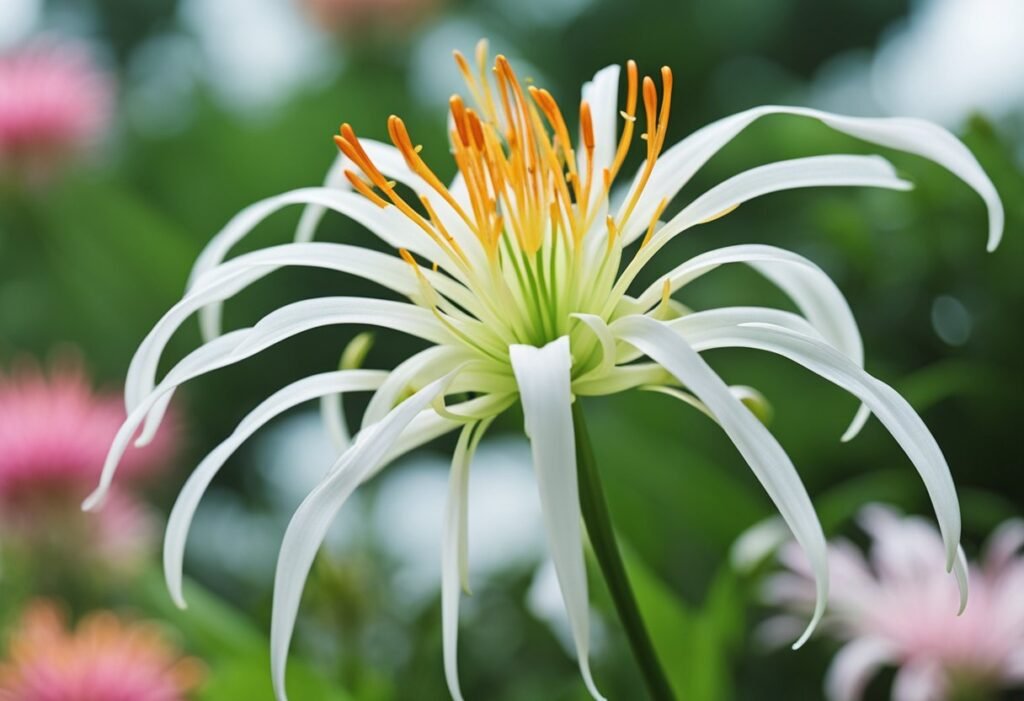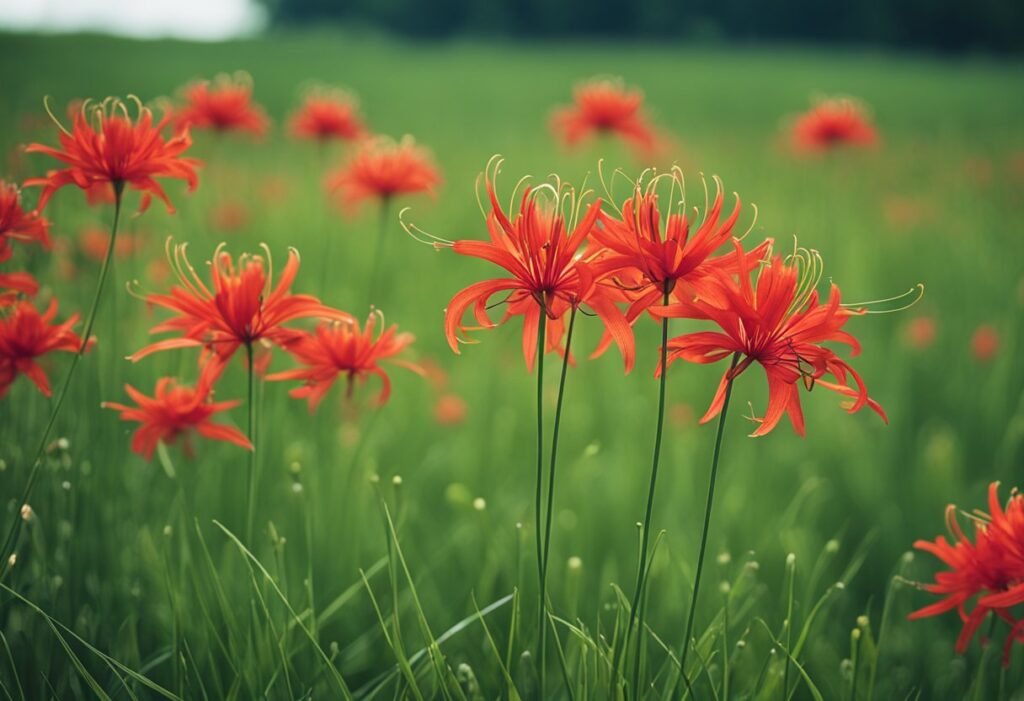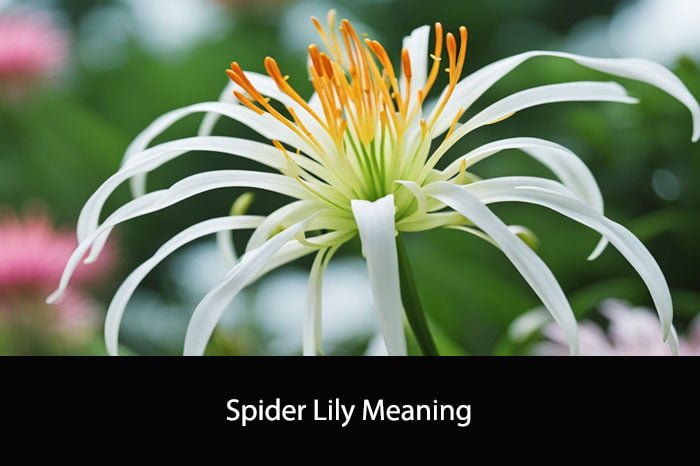Spider lilies are a beautiful and intriguing flower with a rich history and symbolism. These flowers are known for their unique appearance, with long, spindly petals that resemble spider legs. They are native to Asia and are often used in traditional Chinese medicine for their healing properties.
In many cultures, spider lilies are associated with death and mourning. In Japan, they are often planted in cemeteries and used in funerals. However, they also have positive meanings, such as rebirth and renewal. In some parts of Asia, spider lilies are believed to bring good luck and prosperity, making them a popular gift during the Lunar New Year.
Overall, spider lilies have a complex and fascinating meaning that varies depending on the culture and context. Whether you are drawn to their beauty or interested in their symbolism, there is much to explore and learn about these unique flowers.

Origins of Spider Lily
Spider lilies, also known as Lycoris Radiata, are native to China, Japan, and Korea. They are often found in the wild, growing in open fields and along riverbanks. The name “spider lily” comes from the long, thin petals that resemble spider legs.
In Japan, the spider lily is associated with death and reincarnation. It is often planted in cemeteries and used in funerals. In China, the spider lily symbolizes good fortune and is often used in traditional medicine to treat a variety of ailments.
According to legend, the spider lily was created by the goddess Amaterasu when she banished her brother, the storm god Susanoo, from the heavens. As he descended to earth, his tears fell to the ground and sprouted into spider lilies.
Spider lilies have also been used in literature and art throughout history. In Japanese poetry, they are often used to represent the passing of time and the fleeting nature of life. In Chinese art, they are often depicted in paintings and ceramics as a symbol of beauty and elegance.
Overall, the spider lily has a rich cultural history and is deeply rooted in the traditions of East Asia. Its unique appearance and symbolism make it a popular choice for gardens and floral arrangements around the world.
Symbolism and Cultural Significance
Spider lilies have a rich cultural significance in many parts of the world. In Japan, for example, they are associated with death and are often planted in graveyards. This is because the flowers bloom in the fall, which is the season of death in Japanese culture.
In China, spider lilies are known as “ghost flowers” and are also associated with death. However, they are also used in traditional Chinese medicine to treat a variety of ailments, including coughs, headaches, and rheumatism.
In the southern United States, spider lilies are a popular garden plant and are often used in landscaping. They are also associated with the legend of the “Jersey Lily,” a woman named Lillie Langtry who was famous for her beauty and charm in the late 19th century.
Overall, spider lilies symbolize a variety of things depending on the culture and context in which they are found. Some common themes include death, rebirth, and beauty. They are a fascinating and beautiful flower with a rich history and cultural significance.
Spider Lily in Different Cultures
Japan
In Japan, the spider lily is known as “Higanbana” and is associated with death and the afterlife. It is often planted near graves and used in funerals. The flower is believed to guide the dead to the afterlife and is also seen as a symbol of reincarnation.
China
In China, the spider lily is known as “Lycoris radiata” and is associated with good luck and happiness. The flower is often given as a gift to wish someone good fortune and prosperity. It is also used in traditional Chinese medicine to treat various ailments.
United States
In the United States, the spider lily is often used as a decorative plant in gardens and landscaping. It is also sometimes used in floral arrangements and bouquets. The flower is not associated with any particular cultural or symbolic meaning in American culture.
Overall, the spider lily has different cultural meanings and associations depending on the country and region. While it is often associated with death and the afterlife in some cultures, it is also seen as a symbol of good luck and happiness in others.
Spider Lily in Literature and Art
Spider lilies have inspired many literary and artistic works throughout history. Here are a few examples:
- In Japanese literature, spider lilies are often associated with death and the afterlife. They are mentioned in the famous novel “The Tale of Genji” as a symbol of impermanence and the fleeting nature of life.
- The Chinese poem “Red Spider Lily” by Xu Zhimo uses the flower as a metaphor for lost love and regret. The poem describes the beauty of the flower and how it reminds the speaker of a past love that he can never regain.
- In art, spider lilies have been depicted in many different styles and mediums. One famous example is the painting “Red Spider Lily at Hachiman-gu Shrine” by Utagawa Hiroshige, which shows the flower blooming in front of a Shinto shrine.
- Spider lilies have also been used in modern literature and art. For example, the novel “The Spider Lily” by Bruno Schulz tells the story of a man who becomes obsessed with the flower and its symbolism.
Overall, spider lilies have played an important role in the cultural history of many countries and continue to inspire artists and writers today.
Scientific Interpretation
Spider lilies belong to the Amaryllidaceae family and are scientifically known as Lycoris radiata. These flowers are native to Asia and are known for their vibrant red color and unique shape.
The scientific interpretation of spider lilies is that they represent death and reincarnation. This is because the bulbs of the spider lily remain dormant underground for long periods of time before blooming, symbolizing the cycle of life, death, and rebirth.
In addition, the spider lily contains a toxic alkaloid called lycorine, which can cause vomiting, diarrhea, and even death if ingested in large quantities. This toxic element further emphasizes the flower’s association with death.
Spider lilies also have a medicinal use in traditional Chinese medicine. The bulb of the flower is believed to have anti-inflammatory and analgesic properties and is used to treat various ailments such as arthritis, rheumatism, and headaches.
Overall, the scientific interpretation of spider lilies highlights their connection to death and rebirth, as well as their potential medicinal properties.
Spider Lily in Gardening
Spider lilies are a popular choice for gardeners because of their unique appearance and low maintenance requirements. They are known for their striking red color and spider-like shape, which makes them a great addition to any garden.
When planting spider lilies, it’s important to choose a location that receives full sun or partial shade. They prefer well-draining soil and can be planted in either the spring or fall. In terms of watering, spider lilies prefer to be kept on the drier side, so be sure not to over-water them.
One of the benefits of spider lilies is that they are resistant to most pests and diseases, making them an easy plant to care for. They also do not require much fertilizer, although a light application of a balanced fertilizer in the spring can help promote growth.
When it comes to design, spider lilies can be used in a variety of ways. They look great when planted in groups, creating a bold statement in the garden. They can also be used as a border plant or planted in containers for a pop of color on a patio or balcony.
Overall, spider lilies are a great choice for gardeners who want to add a unique and low-maintenance plant to their garden. With their striking appearance and easy care requirements, they are sure to be a favorite for years to come.

Conclusion
In conclusion, spider lilies are a fascinating and meaningful flower with a rich history and symbolism. From their association with death and the afterlife to their representation of new beginnings and hope, spider lilies have a diverse range of meanings across different cultures and contexts.
Through our research, we have discovered that spider lilies are often associated with the Japanese Obon festival, where they are used to guide the spirits of the dead back to the afterlife. In China, spider lilies are associated with the goddess of mercy, Guanyin, and are used to represent the idea of rebirth and new beginnings.
Spider lilies are also known for their striking appearance, with their bright red or pink petals and unique spider-like shape. This has led to their use in various forms of art and literature, as well as their popularity in gardens and floral arrangements.
Overall, spider lilies are a fascinating and meaningful flower with a rich cultural and symbolic history. Whether you are interested in their spiritual significance or simply enjoy their beauty, spider lilies are a flower worth learning more about.
Frequently Asked Questions
What does the spider lily symbolize?
Spider lilies are commonly associated with death, resurrection, and the afterlife. They are often used in funerals and other mourning ceremonies. Some also believe that spider lilies symbolize good fortune and prosperity.
What do spider lilies mean in Japanese culture?
In Japan, spider lilies are known as “Higanbana” and are associated with the Buddhist holiday of Higan. They are often planted near graves and are believed to guide the souls of the dead to the afterlife.
What do spider lilies mean in Chinese?
In China, spider lilies are known as “Lycoris radiata” and are associated with the Mid-Autumn Festival. They are often used in traditional medicine and are believed to have healing properties.
What are the benefits of red spider lilies?
Red spider lilies are believed to have medicinal properties and are used in traditional Chinese medicine to treat a variety of ailments. They are also used in cosmetic products and are believed to have anti-aging properties.
What is the significance of spider lily colors?
Different colors of spider lilies have different meanings. Red spider lilies are associated with passion and love, while white spider lilies symbolize purity and innocence. Yellow spider lilies are associated with joy and happiness.
How is the spider lily used in floral arrangements?
Spider lilies are often used in floral arrangements due to their unique shape and vibrant colors. They are commonly used in bouquets and centerpieces for weddings and other special events. However, it is important to note that spider lilies are toxic and should not be ingested or handled without gloves.





